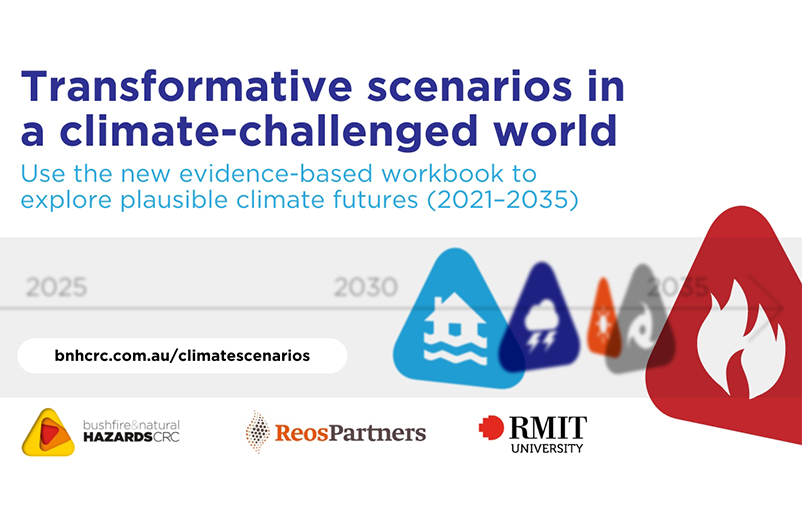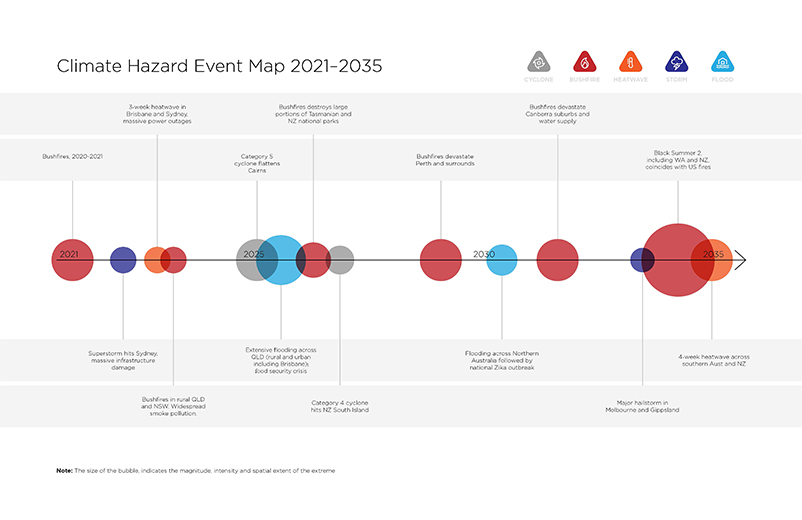Will your organisation be ready for the effects of natural hazards and climate change as they become more significant in the near future? What can you do today to be ready to face a tomorrow that is fundamentally changed by natural hazards and climate?
New resources for Transformative Scenarios in a Climate-challenged World provide plausible futures to help the emergency management sector across Australia and New Zealand. The resources are increasing the understanding of what 2035 could look like under compounding pressures of natural hazards and climate change.
The duration, scale and intensity of the 2019–20 bushfires in Australia, the subsequent disruptions of the COVID-19 pandemic and the destructive flooding this year remind us that the management of natural hazards does not always go as expected, and that we cannot rely on the past as a good indicator of the future. The importance of using plausible futures to adapt and mitigate against likely climatic shifts over the next decade was emphasised by the Intergovernmental Panel on Climate Change Sixth Assessment Report1 on the current knowledge of the physical science of climate change. Importantly, the climate is not the only thing that is changing. Where and how we live will change, the political environment will be different and the social and economic drivers of society will change.

The use of transformative scenarios is a way for organisations to plan for the future. Image: Bushfire and Natural Hazards CRC (now Natural Hazards Research Australia)
The use of transformative scenarios (sometimes called plausible or alternative futures) is a way for organisations to plan for and adapt now to prepare for futures with different social and political drivers and where climate change will result in frequent, severe and compounding natural hazards.
The Transformative Scenarios in a Climate-challenged World resources are based on research lead by Reos Partners in collaboration with RMIT University, through the Bushfire and Natural Hazards CRC ‘Preparing emergency services for operations in a climate-challenged world’ Tactical Research Fund project. The project was supported by the AFAC Climate Change group. The research team worked with leaders in emergency management to develop 4 distinct and plausible scenarios likely to unfold between now and 2035 in Australia and New Zealand, based on current climate trends. The scenarios are presented as 4 variations on social cohesion (low or high) and governance (reactionary or strategic, long-term or short-term).

The Climate Hazard Event Map is one of the resources that can be used to understand the hazard exposures likely to affect an organisation’s services within the plausible future scenarios (2021–2035). Image: Reos Partners, RMIT University and the Bushfire and Natural Hazards CRC (now Natural Hazards Research Australia)
Using the resources
Rather than being a predictive tool, these resources were designed as a package of information that organisations exposed to the risks and effects of natural hazards can use and adapt as needed. This includes emergency management agencies, government departments, community organisations, state-level agencies and other organisations exposed to natural hazards. Using these scenarios, organisations can consider the effects of natural hazards and climate change and assess whether current practices and plans will be sufficient in the context of each plausible future.
The resources are explained using a 'board game' analogy, where organisations can use the ‘pieces’ (resources) to explore how well their current and forward-looking planning prepares them for the future. This allows planners to make informed decisions about how to adapt their services and mitigate against the likely risks to come.
Natural Hazards Research Australia Research Strategy Director, Dr John Bates, explained that these resources include the flexibility to visualise different possible severities of natural hazards so that organisations can develop informed planning solutions.
‘One of the challenges in planning for climate change has been understanding how the continental-scale climate predictions will play out at a local level and combining that with the social, political, economic and environmental changes that will develop alongside, or because of, the changes in the climate.
‘The plausible futures we have developed combine all those elements to help you visualise what our future world might look like. You can use them to see how well current approaches to disaster risk reduction, disaster resilience, emergency response and disaster recovery will work in these futures and explore how actions you can take now could help us all be better prepared for 2035', Dr Bates said.
Lead researchers of this project were Geoff Brown and Stephen Atkinson from Reos Partners and Professor Lauren Rickards and Dr Adriana Keating from RMIT University.


